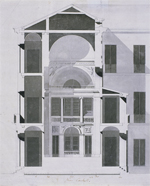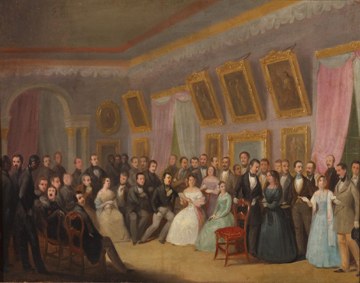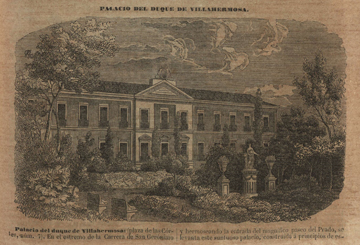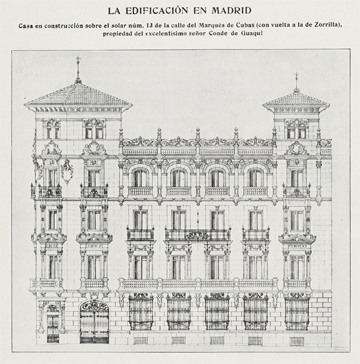Life in palace until the middle of the 20th century
The palace during the Peninsular War and the reign of Ferdinand VII
The duchess had little time to enjoy her palace. The outbreak of the Peninsular War in May 1808 forced her to take refuge in a modest house in the city, the residence of the widow of a former accountant of the family. When the French troops established their artillery batteries in the Retiro park in September, the Villahermosa palace was one of the first buildings to be looted. One of the duchess’s sons perished in the siege of Zaragoza. The other one, José Antonio, was imprisoned and taken to Nancy for five years. Although María Manuela returned to the palace of Villahermosa in 1810, by then she only had the strength to do up the oratory, her bedroom and a few adjoining rooms, where she lived until her death.
Her son José Antonio de Aragón-Azlor, 13th Duke of Villahermosa (1785−1852), returned to Madrid in 1814 and distinguished himself as one of the staunchest defenders of Ferdinand VII (1784−1833). In 1823, Louis Antoine of Bourbon and Savoy, Duke of Angoulême (1775−1844), who had arrived in Madrid with the so-called Hundred Thousand Sons of Saint Louis to put an end to the Liberal Triennium and restore Ferdinand VII to power, was José Antonio’s guest in the Villahermosa palace. Aragón-Azlor was soon appointed ambassador to Portugal and later to Paris.
When he returned to Madrid for good in 1828, José Antonio had the palace appraised along with the adjacent gardens (which at the time included 998 black poplars, 46 cypresses, 24 laurels, 22 fig trees and 18 yew trees, among others). On the basis of its estimated value – more than 9,500,000 reales (80,000 reales annual rent) – the duke began to lease some areas of the palace. It may have been soon after this – around the time of the confiscation and sale of church property ordered by the minister Mendizábal (1836−1837), the demolition of the neighbouring convent of the Espíritu Santo (1843) and the construction of the Congress building (1843−1850) – that the duke sold a large portion of the original garden, making it possible to extend the Calle del Sordo (now Calle de Zorrilla) to the Paseo del Prado.
The palace of Villahermosa houses the Artistic and Literary Lyceum
In 1839, two years after its establishment, the Artistic and Literary Lyceum of Madrid began to operate on the main floor of the Villahermosa palace thanks to a rental agreement with José Antonio de Aragón-Azlor. Under the patronage of Isabella II (1830−1904) and supported by prominent intellectuals – such as writers Ramón de Mesonero Romanos (1803−1882) and José Zorrilla (1817−1893) and painters José Gutiérrez de la Vega (1791−1865), Antonio María Esquivel (1806−1857) and Genaro Pérez Villaamil (1807−1854) − the Lyceum soon became one of the most important cultural institutions of Spanish Romanticism.
Poetry readings, theatrical performances and exhibitions of painting and sculpture – the latter forerunners of the National Exhibitions − were some of the highlights of its six sections: literature, music, painting, sculpture, architecture and theatre. It also hosted concerts and recitals, such as the one given by the Italian tenor Giovanni Battista Rubini (1794−1854) in 1841, and the even more memorable one by the Hungarian pianist and composer Franz Liszt (1811−1886) in 1844, of which there is still a commemorative plaque on the building’s exterior. The Lyceum was also famous for its carnival balls, which brought the season to an end every year with the popular ‘dance of the piñata’.
In the mid-1840s, however, the sections of the Lyceum were reduced to four − literature, fine arts, music and drama − and its activities could no longer compete with those of other institutions, such as the Theatre Royal. It was finally closed in 1851. The duke’s death the following year put an end to the palace’s height of splendour.
The Villahermosa palace during the second half of the 1800s and first half of the 1900s
José Antonio de Aragón-Azlor was succeeded by his son Marcelino, 14th Duke of Villahermosa (1815−1888). Educated in Madrid and Paris and blessed with a profound literary vocation, Marcelino de Aragón-Azlor was a scholarly translator of classical texts and served as a deputy and senator during several terms of government. A fellow student of José Zorrilla at the seminary in Madrid, Marcelino remained close friends with the poet throughout his life and offered him comfortable accommodation in the palace during his stays in Madrid.
This deference to the poet continued to be shown by Marcelino’s daughter and heiress, María del Carmen de Aragón-Azlor, 15th Duchess of Villahermosa (1841−1905). Married in 1862 to the politician José Manuel de Goyeneche, Count of Guaqui (1831−1893), María del Carmen was a patron of the arts like her father. In addition to Zorrilla, another of her guests at the palace was María del Pilar de León, 1st Marquise of Squilache (around 1843−1915), hostess of one of the most famous political and literary gatherings in turn-of-the-century Madrid.
María del Carmen died without issue and the Villahermosa palace passed to a cousin of hers, Francisco Javier de Aragón-Azlor, 16th Duke of Villahermosa (1842−1919). The palace stables, however, went to his brother-in-law, Juan Mariano de Goyeneche, 3rd Count of Guaqui (1834−1924), and his sister, María Josefa de Goyeneche, 1st Duchess of Goyeneche (1839−1926). They had two palaces built: the Goyeneche palace in 1915, and the Guaqui palace – designed by Cesáreo Iradier (1862−around 1939) − in 1917.
In 1929, the old buildings that were part of the Vozmediano entailed estate – located at the junction of the Carrera de San Jerónimo and the Calle del Turco (now Calle del Marqués de Cubas) – were converted into five residential buildings up to seven storeys high. As a result, the Villahermosa palace lost part of its former prominence in this area of the city.
From financial headquarters to museum: the building since the 1950s
- From branch of the Banco Comercial Transatlántico to headquarters of the Banca López Quesada.
- The Villahermosa palace houses the Museo Thyssen-Bornemisza.




